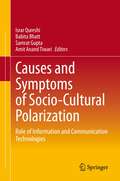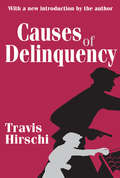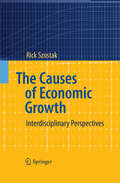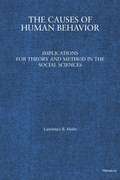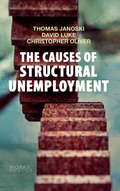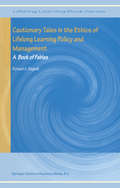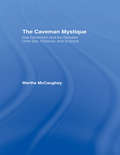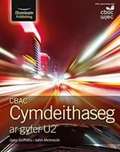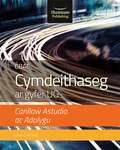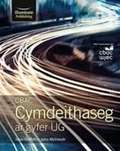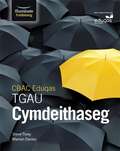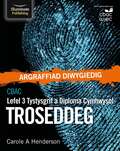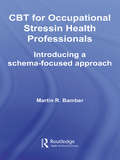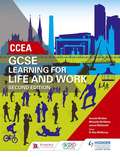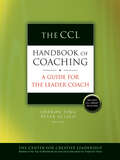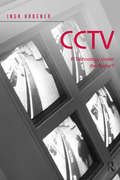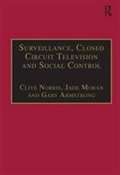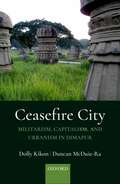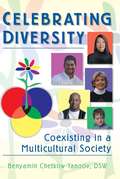- Table View
- List View
Causes and Symptoms of Socio-Cultural Polarization: Role of Information and Communication Technologies
by Israr Qureshi Babita Bhatt Samrat Gupta Amit Anand TiwariThis book explores cultural polarization resultant decline in social cohesion in society and how information and communication technologies exacerbate the cultural polarization through phenomenon such as “echo chambers” of information that damage the quality of online discourse. This book examines the nature of the information that is shared. Further this book identifies how the quality of online discourse and polarization induced through it leads to offline harm and negative outcomes in our society. This book discusses how wide-ranging information exchange on digital media can lead to two scenarios, namely, the formation of the public sphere or the formation of echo chambers. While the public sphere, which promotes greater diversity, is a well-researched domain, substantially less research has been conducted on echo chambers in relation to sociocultural activities, products or services. This book states that polarization induced by the formation and evolution of echo chambers in sociocultural realm such as around epidemic outbreaks, vaccination, healthcare, education, and climate change is an emerging avenue of research due to its enormous impact in the shaping of our society. Therefore, this book argues that understanding the characteristics of sociocultural products related controversies is critical and valuable in developing interventions to reduce unhealthy societal and organizational polarisations. The development of systematic knowledge is required to understand and address such a large scale and complex societal challenge so as to facilitate a deeper understanding and offer solutions to the growing issue of polarization in sociocultural context driven primarily through echo chambers. This book examines how technology enabled social media usage increases, and the complex structural outcomes such as echo chambers are likely to have an increasingly important role in shaping public opinion. This book appeals to readers with interest in developing a deeper and broader understanding of issues and initiatives related to the polarization of opinions on cultural products. These include readers and scholars from various disciplines, along with engaged organizational leaders, activists, policy makers, and common citizens.
Causes of Delinquency
by Travis HirschiIn Causes of Delinquency, Hirschi attempts to state and test a theory of delinquency, seeing in the delinquent a person relatively free of the intimate attachments, the aspirations, and the moral beliefs that bind most people to a life within the law. In prominent alternative theories, the delinquent appears either as a frustrated striver forced into delinquency by his acceptance of the goals common to us all, or as an innocent foreigner attempting to obey the rules of a society that is not in position to make the law or define conduct as good or evil. Hirschi analyzes a large body of data on delinquency collected in Western Contra Costa County, California, contrasting throughout the assumptions of the strain, control, and cultural deviance theories. He outlines the assumptions of these theories and discusses the logical and empirical difficulties attributed to each of them. Then draws from sources an outline of social control theory, the theory that informs the subsequent analysis and which is advocated here.Often listed as a Citation Classic, Causes of Delinquency retains its force and cogency with age. It is an important volume and a necessary addition to the libraries of sociologists, criminologists, scholars and students in the area of delinquency.
Causes of Delinquency
by Travis HirschiIn Causes of Delinquency, Hirschi attempts to state and test a theory of delinquency, seeing in the delinquent a person relatively free of the intimate attachments, the aspirations, and the moral beliefs that bind most people to a life within the law. In prominent alternative theories, the delinquent appears either as a frustrated striver forced into delinquency by his acceptance of the goals common to us all, or as an innocent foreigner attempting to obey the rules of a society that is not in position to make the law or define conduct as good or evil. Hirschi analyzes a large body of data on delinquency collected in Western Contra Costa County, California, contrasting throughout the assumptions of the strain, control, and cultural deviance theories. He outlines the assumptions of these theories and discusses the logical and empirical difficulties attributed to each of them. Then draws from sources an outline of social control theory, the theory that informs the subsequent analysis and which is advocated here.Often listed as a Citation Classic, Causes of Delinquency retains its force and cogency with age. It is an important volume and a necessary addition to the libraries of sociologists, criminologists, scholars and students in the area of delinquency.
The Causes of Economic Growth: Interdisciplinary Perspectives
by Rick SzostakWhat are the causes of economic growth? As billions of people still live in poverty, this is perhaps the most important question in human science. It is also a very complex one, as rates of economic growth are influenced by a multitude of economic as well as political, geographical and sociological factors. This books attempts to advance a nuanced understanding of the process of economic growth by synthesizing the insights of several social science disciplines. Different theories and methods employed by economists and other social scientists to study the causes of economic growth are analyzed and it is shown how and why those insights should be integrated by applying best-practice techniques of interdisciplinary analysis. Scholars and practitioners are thus provided with a wide array of potential strategies for encouraging growth as well as guidance on how these strategies may interact.
The Causes of Human Behavior: Implications for Theory and Method in the Social Sciences
by Lawrence B. MohrAcknowledging that though the disciplines are supposed to be cumulative, there is little in the way of accumulated, general theory, this work opens a dialogue about the appropriate means and ends of social research based in analysis of fundamental issues. This book examines two root issues in the methodology of explanatory social research--the meaning of the idea of causation in social science and the question of the physiological mechanism that generates intentional behavior. Conclusions on these as well as on several derived problems emerge through the analysis. Among the latter, the analysis shows that neither universal nor probabilistic laws governing human behavior are possible, even within the positivist or empiricist traditions in which laws are a central feature. Instead, the analysis reveals a more modest view of what an explanatory social theory can be and do. In this view, the kind of theory that can be produced is basically the same in form and content across quantitative and qualitative research approaches, and similarly across different disciplines. The two streams of analysis are combined with resulting implications for large-sample, small-sample, and case study research design as well as for laws and theory. Written for the practicing empirical researcher in political science and organization theory, whether quantitative or qualitative, the major issuesand findings are meant to hold identically, however, for history, sociology, and other social science disciplines. Lawrence B. Mohr is Professor of Political Science and Public Policy, University of Michigan.
The Causes of Structural Unemployment: Four Factors that Keep People from the Jobs they Deserve (Work & Society)
by Thomas Janoski David Luke Christopher OliverThere is a specter haunting advanced industrial countries: structural unemployment. Recent years have seen growing concern over declining jobs, and though corporate profits have picked up after the Great Recession of 2008, jobs have not. It is possible that “jobless recoveries” could become a permanent feature of Western economies. This illuminating book focuses on the employment futures of advanced industrial countries, providing readers with the sociological imagination to appreciate the bigger picture of where workers fit in the new international division of labor. The authors piece together a puzzle that reveals deep structural forces underlying unemployment: skills mismatches caused by a shift from manufacturing to service jobs; increased offshoring in search of lower wages; the rise of advanced communication and automated technologies; and the growing financialization of the global economy that aggravates all of these factors. Weaving together varied literatures and data, the authors also consider what actions and policy initiatives societies might take to alleviate these threats. Addressing a problem that should be front and center for political economists and policymakers, this book will be illuminating reading for students of the sociology of work, labor studies, inequality, and economic sociology.
The Causes of Structural Unemployment: Four Factors that Keep People from the Jobs they Deserve (Work & Society)
by Thomas Janoski David Luke Christopher OliverThere is a specter haunting advanced industrial countries: structural unemployment. Recent years have seen growing concern over declining jobs, and though corporate profits have picked up after the Great Recession of 2008, jobs have not. It is possible that “jobless recoveries” could become a permanent feature of Western economies. This illuminating book focuses on the employment futures of advanced industrial countries, providing readers with the sociological imagination to appreciate the bigger picture of where workers fit in the new international division of labor. The authors piece together a puzzle that reveals deep structural forces underlying unemployment: skills mismatches caused by a shift from manufacturing to service jobs; increased offshoring in search of lower wages; the rise of advanced communication and automated technologies; and the growing financialization of the global economy that aggravates all of these factors. Weaving together varied literatures and data, the authors also consider what actions and policy initiatives societies might take to alleviate these threats. Addressing a problem that should be front and center for political economists and policymakers, this book will be illuminating reading for students of the sociology of work, labor studies, inequality, and economic sociology.
Cautionary Tales in the Ethics of Lifelong Learning Policy and Management: A Book of Fables (Lifelong Learning Book Series #1)
by Richard G. BagnallThis work is concerned with appraising the contemporary ethical impact of lifelong learning ideology and advocacy on education, through focusing on trends in educational policy and management that flow from the ideology. It has its origins in the author's concern that many of those trends are being defmed and promoted, or opposed, without an adequate understanding of their ethical dimensions. The 21 trends examined in this work are seen as defming important dimensions of the quite radical changes in educational policy and management that are flowing from the practical realisation of lifelong learning ideology and advocacy. In here evaluating those trends from an ethical perspective, the thesis is developed that they lead inevitably to distinctive ethical dilemmas or tensions in the lived experience of educational participants. The dilemmas, though, are not seen as realities that can intelligently be either avoided or resolved. They are, rather, inescapable features of the trends, although they and the experience of them may be managed intelligently to a greater or lesser extent. This analysis is premised on the belief that an understanding of the dilemmas may be of practical value in assisting educators, and policy makers and managers, to live and work more intelligently with them and to better manage the educational changes that are defmed by the trends. It may thereby contribute to moderating the excesses, sillinesses, and inanities so often evident in the directing and managing of refonns associated with the trends and to reduce the anguish and pain associated with them.
The Caveman Mystique: Pop-Darwinism and the Debates Over Sex, Violence, and Science
by Martha McCaugheyHas evolution made men promiscuous skirt chasers? Pop-Darwinian claims about men's irrepressible heterosexuality have become increasingly common, and increasingly common excuses for men's sexual aggression. The Caveman Mystique traces such claims about the hairier sex through evolutionary science and popular culture. After outlining the social and historical context of the rise of pop-Darwinism's assertions about male sexuality and their appeal to many men, Martha McCaughey shows how evolutionary discourse can get lived out as the biological truth of male sexuality. Although evolutionary scientists want to use their theories to solve social problems, evolutionary narratives get invoked by men looking for a Darwinian defense of bad-boy behaviors. McCaughey argues that evolution has nearly replaced religion as a moral guide for understanding who we are and what we must overcome to be good people. Bringing together insights from the fields of science studies, body studies, feminist theory and queer theory, The Caveman Mystique offers a fresh understanding of science, science popularization, and the impact of science on men's identities making a convincing case for deconstructing, rather than defending, the caveman.
The Caveman Mystique: Pop-Darwinism and the Debates Over Sex, Violence, and Science
by Martha McCaugheyHas evolution made men promiscuous skirt chasers? Pop-Darwinian claims about men's irrepressible heterosexuality have become increasingly common, and increasingly common excuses for men's sexual aggression. The Caveman Mystique traces such claims about the hairier sex through evolutionary science and popular culture. After outlining the social and historical context of the rise of pop-Darwinism's assertions about male sexuality and their appeal to many men, Martha McCaughey shows how evolutionary discourse can get lived out as the biological truth of male sexuality. Although evolutionary scientists want to use their theories to solve social problems, evolutionary narratives get invoked by men looking for a Darwinian defense of bad-boy behaviors. McCaughey argues that evolution has nearly replaced religion as a moral guide for understanding who we are and what we must overcome to be good people. Bringing together insights from the fields of science studies, body studies, feminist theory and queer theory, The Caveman Mystique offers a fresh understanding of science, science popularization, and the impact of science on men's identities making a convincing case for deconstructing, rather than defending, the caveman.
CBAC Cymdeithaseg ar gyfer U2 (PDF)
by Janis Griffiths John McIntoshEndorsed by WJEC and written by experienced A Level Sociology teachers and examiners. Provides thorough support for the assessment objectives with clear explanations of the new assessment weightings. Exam support sections introduce students to exam-style practice questions, new assessment objectives and guide students on the skills they need for assessment.
CBAC Cymdeithaseg ar gyfer UG Canllaw Astudio ac Adolygu (PDF)
by Janis GriffithsThis full-colour Study and Revision Guide is designed to accompany your students through their Sociology course as well as prepare them for the final exams. It provides study support as well as revision support.
CBAC Cymdeithaseg Uwch Gyfrannol (PDF)
by Janis Griffiths John McIntoshEndorsed by WJEC and written by experienced A Level Sociology teachers and examiners Provides thorough support for the assessment objectives with clear explanations of the new assessment weightings. Exam support sections introduce students to exam-style practice questions, new assessment objectives and guide students on the skills they need for assessment.
CBAC Eduqas TGAU Cymdeithaseg (PDF)
by Steve Tivey Marion DaviesEndorsed by WJEC Eduqas and written by two experienced teachers, this accessible and engaging Student Book provides high quality support you can trust.
CBT for Occupational Stress in Health Professionals: Introducing a Schema-Focused Approach
by Martin R. BamberThe costs of occupational stress in terms of sickness absence, ill-health-related retirement, litigation and lost productivity are increasing, putting strain on economies across the world. The fact that health care work is inherently more stressful than many other occupations makes it vital that the problem of occupational stress among health professionals is addressed. CBT for Occupational Stress in Health Professionals goes beyond simply defining the problem and fills a gap in the current literature by providing clear and concise individual treatment interventions. In three parts, the book covers: an overview of stress in the occupational context the standard CBT approach to assessment, formulation and treatment a new schema-focused approach to treating occupational stress. The schema-focused approach presented here provides powerful tools for treating a range of work-related problems for which standard CBT approaches are ineffective. Case studies are presented throughout the book to illustrate the therapeutic approaches described. This book will be of huge benefit to clinical and organizational psychologists, psychiatrists, mental health workers, counsellors and anyone else involved in treating occupational stress. It will also have much to offer those who manage people suffering from stress, human resource workers and those who are experiencing work-related stress.
CBT for Occupational Stress in Health Professionals: Introducing a Schema-Focused Approach
by Martin R. BamberThe costs of occupational stress in terms of sickness absence, ill-health-related retirement, litigation and lost productivity are increasing, putting strain on economies across the world. The fact that health care work is inherently more stressful than many other occupations makes it vital that the problem of occupational stress among health professionals is addressed. CBT for Occupational Stress in Health Professionals goes beyond simply defining the problem and fills a gap in the current literature by providing clear and concise individual treatment interventions. In three parts, the book covers: an overview of stress in the occupational context the standard CBT approach to assessment, formulation and treatment a new schema-focused approach to treating occupational stress. The schema-focused approach presented here provides powerful tools for treating a range of work-related problems for which standard CBT approaches are ineffective. Case studies are presented throughout the book to illustrate the therapeutic approaches described. This book will be of huge benefit to clinical and organizational psychologists, psychiatrists, mental health workers, counsellors and anyone else involved in treating occupational stress. It will also have much to offer those who manage people suffering from stress, human resource workers and those who are experiencing work-related stress.
CCEA GCSE Learning For Life And Work (2nd Edition) (PDF)
by Amanda McAleer Michaella McAllister David McVeigh Joanne McDonnellExam Board: CCEA Level: GCSE Subject: Learning for Life First Teaching: September 2017 First Exam: June 2019 Enable students to critically engage with the new content and assessment requirements with this fully updated edition of the market-leading Student's Book for CCEA GCSE Learning for Life and Work - Provides complete coverage of the new content and assessment requirements with support at every stage from experienced teachers and subject experts David McVeigh, Michaella McAllister and Amanda McAleer - Prepares students for assessment with skills-building activities, practice questions and structured guidance on how to approach questions successfully - Helps engage students through accessible diagrams, research activities and a bank of up-to-date case study material - Develops subject knowledge through clear and detailed coverage of the key content structured around the specification
The CCL Handbook of Coaching: A Guide for the Leader Coach (J-B CCL (Center for Creative Leadership) #30)
by Sharon Ting Peter SciscoCoaching is vital to developing talent in organizations, and it is an essential capability of effective leaders. The CCL Handbook of Coaching is based on a philosophy of leadership development that the Center for Creative Leadership has honed over thirty years with rigorous research and with long, rich experience in the practice of leadership coaching. The book uses a coaching framework to give a compass to leaders who are called to coach as a means of building sustainability and boosting performance in their organizations. The book explores the special considerations that leader coaches need to account for when coaching across differences and in special circumstances, describes advanced coaching techniques, and examines the systemic issues that arise when coaching moves from a one-to-one relationship to a developmental culture that embraces entire organizations.
The CCL Handbook of Coaching: A Guide for the Leader Coach (J-B CCL (Center for Creative Leadership) #30)
by Sharon Ting Peter SciscoCoaching is vital to developing talent in organizations, and it is an essential capability of effective leaders. The CCL Handbook of Coaching is based on a philosophy of leadership development that the Center for Creative Leadership has honed over thirty years with rigorous research and with long, rich experience in the practice of leadership coaching. The book uses a coaching framework to give a compass to leaders who are called to coach as a means of building sustainability and boosting performance in their organizations. The book explores the special considerations that leader coaches need to account for when coaching across differences and in special circumstances, describes advanced coaching techniques, and examines the systemic issues that arise when coaching moves from a one-to-one relationship to a developmental culture that embraces entire organizations.
CCTV: A Technology Under the Radar?
by Inga KroenerCentral state and non-covert surveillance began in earnest at the start of the twentieth century. By the start of the twenty-first century, the UK was one of the most surveilled societies on earth. This groundbreaking volume by Inga Kroener analyses the particular combination of factors that have created this surveillance state. Kroener argues against the inevitability of the rise of CCTV that is so often found in this literature, to map out the early history of CCTV, tracing its development from a tool for education, safety and transport during the 1950s, to one of politics in the 1970s and 1980s, to eventually become a tool of surveillance during the 1990s. Within this analysis, the complex role of the public in 'allowing' the widespread and rapid dissemination of CCTV is discussed and the representation of CCTV in the media is also studied. This volume will be of interest to all scholars working in the fields of surveillance studies; science, technology and society departments; and social historians more generally.
CCTV: A Technology Under the Radar?
by Inga KroenerCentral state and non-covert surveillance began in earnest at the start of the twentieth century. By the start of the twenty-first century, the UK was one of the most surveilled societies on earth. This groundbreaking volume by Inga Kroener analyses the particular combination of factors that have created this surveillance state. Kroener argues against the inevitability of the rise of CCTV that is so often found in this literature, to map out the early history of CCTV, tracing its development from a tool for education, safety and transport during the 1950s, to one of politics in the 1970s and 1980s, to eventually become a tool of surveillance during the 1990s. Within this analysis, the complex role of the public in 'allowing' the widespread and rapid dissemination of CCTV is discussed and the representation of CCTV in the media is also studied. This volume will be of interest to all scholars working in the fields of surveillance studies; science, technology and society departments; and social historians more generally.
Cctv, Surveillance And Social Control
by Clive Norris Jade Moran Gary ArmstrongThe rise of CCTV camera surveillance in Britain has been dramatic. Practically every major city now boasts a CCTV system aimed at, among other things, preventing, detecting and reducing the fear of crime. Increasingly these developments are mirrored in villages, shopping malls, residential estates, transport systems, schools and hospitals throughout the country. In short, for the majority of citizens it is now impossible to avoid being monitored and recorded as we move through public space. Surveillance, CCTV and Social Control represents the first systematic attempt to account for this phenomenon. It brings together leading researchers from the fields of anthropology, criminology, evaluation, geography, sociology and urban planning to explore the development, impact and implications of CCTV surveillance. Accordingly attention is directed to a number of key questions. How does CCTV fit with the trends of late modernity? Does CCTV reduce crime or merely shift it elsewhere? How should CCTV be evaluated? What is the significance of CCTV for women's safety? How adequate is the regulation of CCTV? In the light of recent technological developments what is the future of CCTV surveillance?
Ceasefire City: Militarism, Capitalism, and Urbanism in Dimapur
by Dolly Kikon Duncan McDuie-RaFor a city in India's northeast that has been embroiled in the everyday militarization and violence of Asia's longest-running separatist conflict, Dimapur remains 'off the map'. With no 'glorious' past or arenas where events of consequence to mainstream India have taken place, Dimapur's essence is experienced in oral histories of events, visual archives of the everyday life, lived reality of military occupation, and anxieties produced in making urban space out of tribal space. Ceasefire City aims to capture the dynamics of Dimapur by bringing together the fragmented sensibilities granted and contested in particular spaces in the city and the embodied experiences of the city by its residents. The first part of the book talks about military presence, capitalist growth, and urban expansion in Dimapur through an analysis of its spatial politics, and the second part, through collaborative ethnographic exercises, focuses on the relationship between the lived realities and the meanings that are forged around the city.
Celebrating Diversity: Coexisting in a Multicultural Society
by Carlton Munson B Harold Chetkow-YanoovCelebrating Diversity: Coexisting in a Multicultural Society, offers pragmatic ways to replace conflictive behaviors between diverse peoples with coexistence alternatives. Coexistence-partnership values and skills help us to outgrow ways of the past--competition, suspicion, manipulation, isolation, victimization. These skills enhance our own lives as well as those of future generations.In Celebrating Diversity, author Benyamin Chetkow-Yanoov asserts that the increasing religious-ethnic-linguistic pluralisms of the twentieth century requires that we cease lumping people different from ourselves into an “other” category. He identifies classical elements of a coexistence model and suggests various strategies and tactics for implementing coexistence in modern societies. Among the many insights you will find are: the definition of coexistence an analysis of past patterns of majority-minority group relations, such as segregation, tolerance, and integration models of majority-minority relations, participation, and coexistence appropriate for the twenty-first century illustrations of the coexistence model through examples of places where it is flourishing action steps for leaders and citizens to put the idea of coexistence into practice a range of research findings that help us determine what is effective in promoting coexistenceIn the pages of Celebrating Diversity, you can learn social skills for preventing conflict escalation, for finding areas of common interest, and for working cooperatively. As more of us become informed about alternatives to violence, hopefully we can find ways to bring peace to areas of unrest, such as Algeria, Ireland, Israel, Nigeria, Rwanda, Serbia, or the former Soviet Union.
